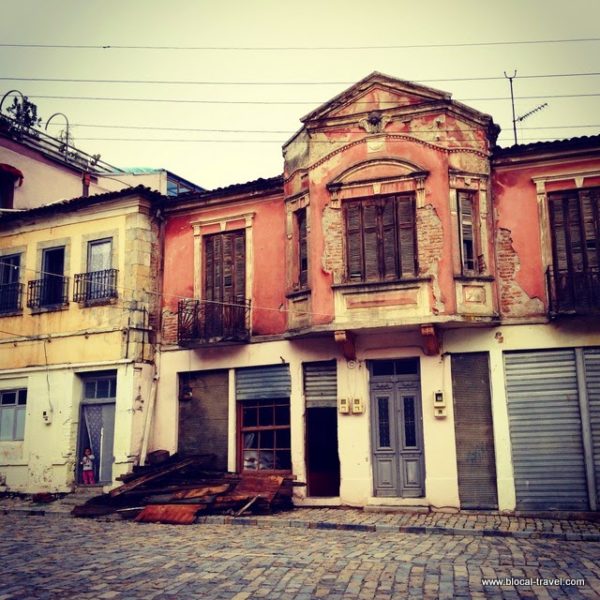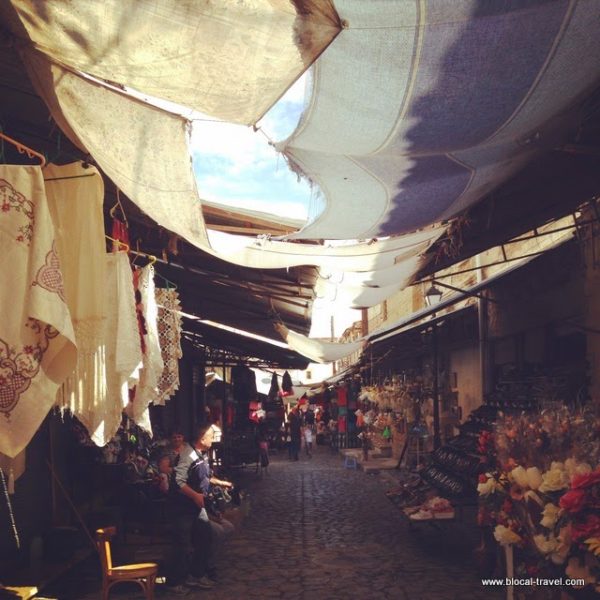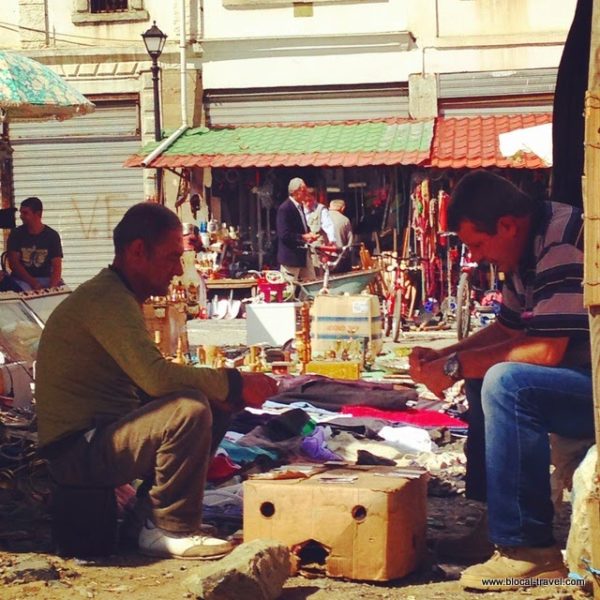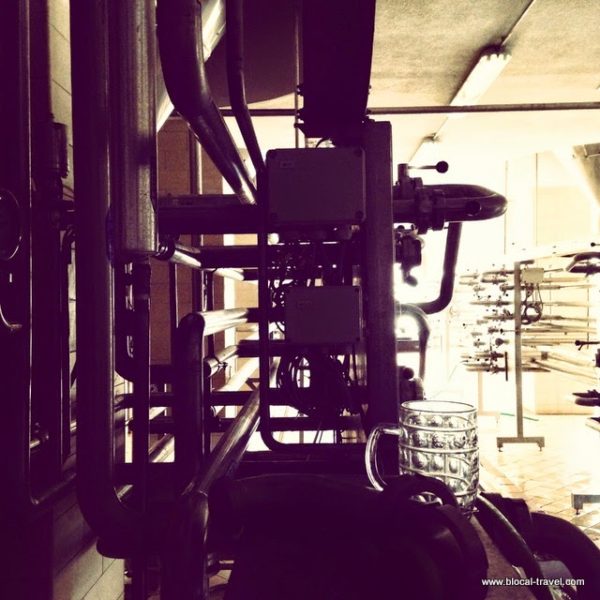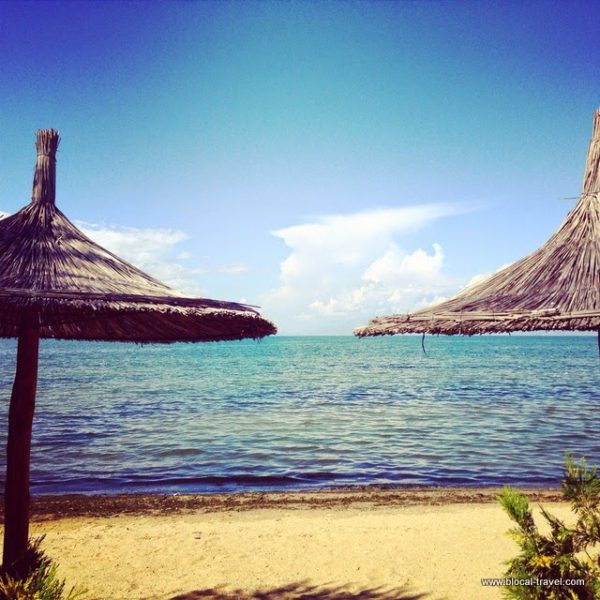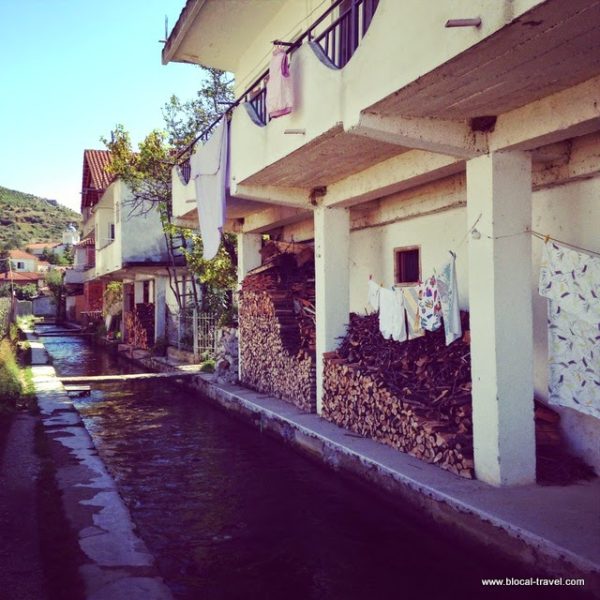18.6K
If you ask me which is the Albanian place I liked the most, the answer is Korça.
The town of intellectuals, artists and poets really got me, and I wouldn’t mind spending some time living there in the future. I would love it, actually!
Korça is characterised by wide boulevards with many cafes where locals enjoy a Turkish coffee or more often a beer or a raki –well, actually male locals, as it is very rare to spot girls on a night out on their own.
A lot of Korça life is going on along those beautiful boulevards: vendors selling each kind of goods from cigarettes to socks and corns on the cob, elders playing dominoes, children running around with their gang, youngsters showing off their new cars (which -more often than not- are Mercedes), and the whole town gathers along Korça boulevards at evening to indulge in the traditional xhiro, meaning that they stroll around stopping to chat & catch up when they meet someone they know. During our three days in Korça, the boulevards have been our favourite and most rewarding place to engage in some people-watching!
I was a bit skeptical reading on-line that Korça is considered the “Albanian Paris” but, once there, I totally got why: besides the boulevards, the cafes and the famous Korça serenades, the overall atmosphere in Korça is that of a cultural town with a well-finished architecture and several interesting and peculiar museums, a city which has been home for artists and intellectuals in the vanguard for Albanian culture, which actually kind of reminds last-century Paris and its cultural swarm.
Of course, out of all these well-finished architectures what I liked the most is the decadent charm of Korça houses, especially in the area behind the Orthodox Cathedral. I loved this charming neighbourhood, with its ancient houses (some of them dating back to the Ottoman era), its cobbled streets and its romantic atmosphere somehow suspended in time.
Among other examples of a more modern architecture, I appreciated the eclectic style of the Romanian House from the 1930s and the majestic architecture of the Orthodox Cathedral, which is the largest Cathedral of Albania and the second largest in the Balkans. Its magnificence symbolises the return of religious practices in a country where all religions were banned during the communist era.
What you shouldn’t miss in Korca
The Old Bazaar
The old bazaar of Korça is one of the most beautiful Ottoman bazaars in the Balkan countries, which gives historical and monumental meaning to the city. Its charm dates back many centuries when Korca bazaar was the site of exchange for traders not only from Albania but also from Turkey, Greece, Trieste and Venice.
We visited the old bazaar of Korça at its most bustling time and wandered around its striking narrow alleys connecting several small squares to each other and surrounded by beautiful decadent buildings from its Ottoman past. Even if nowadays all the selling happens on outdoor stands and not anymore within those charming small buildings, the old bazaar still largely contributes to the romantic and somehow poetic atmosphere of Korça I treasure in my mind.
At the Korça bazaar, you can find fresh fruits and vegetables, cheeses, spices, tasty lakror (that’s how they call the burek in Korça) and grilled meat to eat on the spot but also odds and ends, objects from the past, clothes, trinkets, artisanal crafts and more.
At this point of the trip -after four days spent on the Albanian Riviera and three more days between Gjirokaster and Permet– we already matched the name “Korça” with the national beer and so, even before arriving in town, I knew I wouldn’t leave Korça without visiting its well-known brewery.
Opened in 1929, Korca Brewery is the very first Albanian Brewery; and even if its plant was renewed in 2006, the building was kept to its original architectural design. When we arrived at the brewery, everybody looked surprised by our request of touring the factory, but after a while they introduced us to Illiri, an Albanian guy very fluent in Italian who kindly showed us around the fabric, showing us the production chain of their famous beer.
He even offered us a glass of not-filtered Korça straight from the source, and it tasted exceptionally scented and citrus-ish: too bad they don’t sell it like that!
Illiri explained to us that now the production is now all computerised, but the water they use still comes from the natural springs on Morava Mountain, a mountain visible in all its majestic beauty from the brewery’s yard.
And if you happen to be around in the middle of August, don’t miss the annual beer festival organised by the Korça brewery!
Daytrip #1 – Lakes Prespa and Ohrid
The two Lakes of Prespa are the highest tectonic lakes of the Balkans; the whole surrounding area is a National Park which lately had been added to the UNESCO’s world network of biosphere reserves. Within the Great Prespa Lake (which shares its waters between Albania, Greece and Macedonia) there is the tiny, inhabited isle of Maligrad with the 14-century frescoed St. Mary’s church. Unfortunately, we didn’t manage to get to the island, but we did enjoy a relaxing time on the lake shores in the village of Liqenas.
Tushemisht overlooks Lake Ohrid, the deepest lake in the Balkans and one of the oldest lakes in the world, also listed among the UNESCO’s world heritage sites together with the Macedonian town of Ohrid. It borders with Macedonia, but luckily the Albanian side is way wildest. Tushemisht is a very beautiful and relaxed village, definitely the place we liked the most on Lake Ohrid shores!
The village has several small canals filled with natural spring water overlooked by small houses, a main street with many beautiful backyards full of potted plants and small vegetable gardens and the village itself is very colourful with all its lovely painted benches and flower pots.
Situated on the shores of Ohrid Lake and surrounded by hills and high mountains, Pogradec is a very popular destination for Albanian tourism. Despite the archaeological evidence showing that Pogradec area has been inhabited since the late Neolithic period, today’s Pogradec is a crowd of modern buildings, extremely high lakefront hotels, wide chaotic roads –among which the state highway itself, which runs in the middle of the city- and touristic restaurants suspended on the lake. Let’s just say it isn’t the place we liked the most of the overall holiday, even if we did love the Pogradec waterfront with its colourful fishermen’s boats lying on the beach and the old people playing dominoes on the benches. I really got crazy about these boats taking many pictures, attracted by the foggy atmosphere of the late afternoon when the lake mirrors the mountains and the clouds while the boats look suspended in a very romantic state of being.
We arrived as far as the green area of Drilon, the place where Enver Hoxha and the most senior Communist officials spent their holidays and therefore it was off-limits for ordinary citizens as the Blloku neighbourhood of Tirana.
Still on Lake Ohrid, on the morning after we visited the tiny village of Lin on our way to Berat, a very picturesque fishermen village situated on a small peninsula made of small houses ending straight on the lake shores.
Here we stopped for a coffee break from driving along the very panoramic road running near Lake Ohrid, on our (long) way to Berat. I meant to stop in Elbasan as well to visit the huge industrial archaeology site of Kombinati Metalurgjik, so we didn’t have the time to visit the Illiryan basilica and its mosaics on the nearby mountain… but if you happen to be in Lin I suggest you to visit it!
Daytrip #2: Boboshtica
Boboshtica is the village of mulberry trees, churches and remarkable restaurants. Long story short we are not able to recognise mulberry trees, we found only three churches and they were closed, but we surely fulfilled the remarkable restaurants’ part by eating grilled meat and vegetables in a gardened restaurant where a table of drunk locals delighted us with Albanian folk songs and Korça serenades.
Anyway following the road across Boboshtica you can reach Dardha, a popular skiing destination which was on my bucket list but we skipped it for being too exhausted by eating!
Daytrip #3 Voskopoja
Let’s keep Voskopoja’s churches and mosaics for another episode, shall we?
Now you can check it out > The quest for the key of Voskopoja.
Korça> Where to stay
We stayed at Bujtina Leon, a delicious Ottoman Inn behind the Orthodox Cathedral. This guesthouse is beautiful; the owners are very kind, and the lady definitely knows how to make a tasty breakfast!
Korça> Where to eat
Birra Korça Restaurant, Korça
After the visit of the brewery and a 10-am pint of not-filtered Korça, the moment to eat arrived. We welcomed it on a wooden table at the Birra Korça tavern -which is right in front of the factory- where we had a tasty spit-roasted chicken -of course, washed down with a lot of Korça Beer!
Vila Melko, Boboshtica
This is the first of many taverns you will find on Boboshtica main street. It has a big garden with many individual patios, and the food is delicious! We had grilled meat and vegetables, fries and many other traditional specialities and we enjoyed the atmosphere of the restaurant with locals singing traditional Korça serenades under the patio.
Taverna Agai, Tushemisht
Lake Ohrid is home to various endemic species of plants and animals, including the koran, an ancient and delightful variety of trout, which you can admire in all its beauty in the following picture ;-)
When it was time to eat, we spotted a group of police officers going on their lunch break and we followed them to the tavern across the street because who know which is the best restaurant in town better than local traffic corps? And so we ended up at Taverna Agai where, besides the koran, we also tasted the lakror, fresh vegetables and a great white local wine.
You can hover over these (or any image) to quickly pin it!
PEEK THROUGH | You find Korca and the beautiful places mentioned above in my video “My 13-days road-trip around Albania…in 130 seconds”





